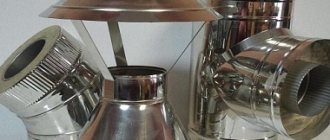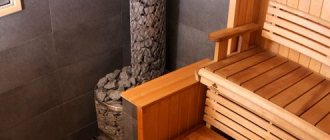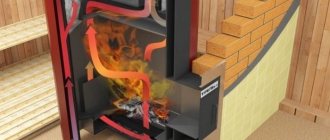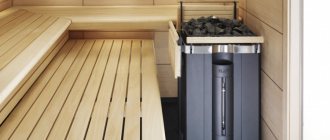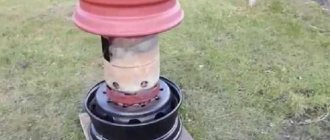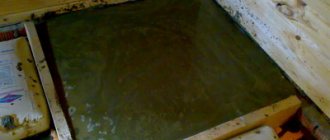In our country it is rare to meet a person who has a “cool” attitude towards the bathhouse. Therefore, when building a house or cottage, the bathhouse is often the first to be built on the site. Let's figure out how to build a sauna heater with your own hands. After all, many people prefer traditional stoves, although now an electric heater can also be purchased.
DIY sauna heater
Advantages of a brick stove
Brick stove-heater
A stove made of brick has a large closed heater; designs of other materials cannot compete with it in terms of the quality of the steam produced. The advantages of this design are:
- Fire safety;
- long-term heat retention;
- the ability to heat a large area;
- ease of operation and no need to add fuel during the washing process;
- uniform heating of the room;
- lack of contact between stones and combustion products.
The disadvantages of a stone stove include its impressive weight, which requires laying a separate foundation, and the need to preheat the bath.
Metal heaters: pros and cons
Made of metal
If desired, you can weld a steel stove for a bath. A container for stones is installed above its firebox. This option is cheaper and can be manufactured faster and easier than a brick structure. Cast iron cannot be used for metal heaters; cracks will occur when water gets on it. Among the advantages of a steel heating device:
- compact size;
- light weight;
- fast warm-up.
When choosing how to make a heater for a bath, the disadvantages of the stove are also taken into account; rapid cooling after combustion stops, uneven heating of the bath, fire hazard.
The brick stove is installed so that it heats all the rooms. Its front part with the combustion door and ash pan goes to the dressing room. The location for the structure is chosen when designing the bathhouse, because you need to take into account the required distance from the wall to the stove and build a solid foundation.
Popular manufacturers
You can purchase a finished heater only in a certain design. These can be steel or cast iron models, since brick heaters are built directly on site and are not found on sale.
Among the most famous manufacturers of cast iron stoves are the following companies:
Hephaestus
Etna
Inzhkomcenter VVD
Vesuvius
These are domestic manufacturers offering models with the optimal combination of price and performance characteristics.
Among the companies supplying steel furnaces to the market, the following should be highlighted:
Termofor
Teplodar
Ermak
Varvara
The stove models manufactured by these companies are durable and made of thick metal. They do not burn out for a long time and allow you to heat rooms quickly and efficiently.
As you can see, only domestic companies are listed. This was done deliberately, since these companies offer very high-quality, competitive products. At the same time, the cost of their stoves is significantly lower than that of imported analogues, which determines the choice of buyers.
Heater location
Depending on the area of the steam room, a stove of a suitable size is designed. If, as a result, the heater takes up space up to 2 m2, then it can be installed in a specially made niche in the wall. Due to this, heat loss can be prevented, since its combustion will be carried out directly from the steam room. Although in most cases the heater is designed in such a way that its firebox is carried out from the next room.
A sauna stove should be installed so that the heat from it spreads into the dressing room, washing room and steam room. Thanks to this, it will be possible to make a common chimney with three separate chimney channels for a gas boiler, fireplace and heater stove.
Useful properties of steam
It is impossible to imagine a real Russian bathhouse without steam. Steam expands skin pores and removes harmful toxins from the body. The skin becomes more elastic and firm.
Heat dilates blood vessels, stimulating metabolism. The human brain is freed from mental and emotional stress, bringing the entire body into a peaceful state.
The heat of a steam room is an excellent cure for joint disease. It was not for nothing that our ancestors loved going to the bathhouse, mercilessly whipping themselves there with brooms, and to get steam, you would need a sauna heater. Let's figure out how to choose a heater for a bath or make it yourself. Most often, a traditional wood stove is used, although an electric one can be installed.
Water container
Immediately before building the stove, it is important to determine the volume of the tank in which the water will be heated. The volume of the tank will depend on the intensity of visiting the steam room. So, the calculation is made based on one liter of hot water per person. It is best to use an open container. Although there will be evaporation, there are a number of positive aspects:
- Convenient when filling the container.
- The ability to carry out maintenance or repair of the internal part if necessary, for example, remove scale, clean and dry.
- In winter, completely remove water, protecting the tank from freezing the water in it.
Water tank
The size of the container for heating the liquid is determined based on the maximum number of users of the sauna. If we consider that up to 10 liters should be enough for one person, then the volume of the container is calculated by multiplying this number by the expected number of users.
By choosing an open type tank, you definitely get the following advantages:
- ease of filling the container with water;
- free access to the oven;
- ease of cleaning the tank from scale;
- easy removal of liquid residues to prevent it from freezing without the need to kindle the bath in winter.
When using an open container, only a small amount of evaporation is allowed.
Foundation for a brick stove-heater
If you want the stove you made to last for many years, you should take care of making a reliable foundation for it. In this case, be sure to take into account the following nuances:
- The foundation of the bathhouse and heater must be different, especially if the total mass of the stove exceeds 700 kg. There must be a distance of at least 500 mm between them.
- The foundation for the heater must have a depth below the soil freezing level of an average of 700 mm. In different regions of Russia, the level of soil freezing is different.
- The size of the foundation should be half a brick larger than the stove itself on each side.
So, let's look at the step-by-step process of making a foundation for a stove:
- To begin, dig a pit with a depth below the soil freezing level, on average 700 mm. The size of the pit around the perimeter should be 100–150 mm wider. This will allow you to easily install the formwork, and fill the resulting gap with sand or gravel.
- At the bottom of the pit we make a sand cushion. At the exit it should have a thickness of 150 mm. After pouring a layer of sand, water it with water to compact it. As water is absorbed, the sand will settle, so you will need to add it to the desired thickness.
- When the water is completely absorbed, a layer of stones or broken bricks is poured on top of the sand. It needs to be compacted. The resulting gaps between the stones should be filled with sand and watered. It is very important that the sand fills the space between the battle and the stones as densely as possible. The thickness of this layer, in our example, will be 250 mm.
- If the sand has stopped settling, then the next layer of crushed stone can be backfilled. It also needs to be compacted well.
- Now you need to make formwork from boards 40 mm thick. The internal size of the formwork must correspond to the size of the foundation. The top of the formwork must be leveled. It should be securely fixed in the pit and a reinforcement cage should be placed inside it. There should be 50 mm between the formwork walls and the frame.
- At the next stage, perform concreting. In this case, it is necessary to tamp with a piece of steel reinforcement or a wooden beam. The upper level of liquid concrete must be brought to the edges of the formwork. The surface of the screed should be smooth. As a result, the formwork should be on the same level as the subfloor of the bathhouse. The poured concrete must be left for several days to set.
- When the concrete has acquired sufficient strength, the formwork must be removed. The surface of the concrete is covered with two layers of molten tar. After this, fill the space between the walls of the soil and the concrete with sand or gravel. After this, cover the concreted area with plastic film and wait 7 days. Then you can start laying bricks.
The base for the furnace is made of reinforced concrete slabs
There is another way to make a foundation if you are installing a sauna stove with your own hands. A 150-mm reinforced concrete slab with a reinforced layer at the bottom is laid in the base. The larger the area of the stove, the higher the reliability of the stove structure.
When the soil in the area is moist clayey (loamy), then to prevent seasonal fluctuations in the foundation it is necessary to lay several piles under the reinforced concrete foundation so that the slab has support.
Piles are made in the following sequence:
- Using a garden auger with a diameter of 20 centimeters, make a cylindrical hole one meter deep.
- Rubble is poured into the bottom of the pit in a layer of 15 centimeters and compacted.
- Then a kind of tube is rolled out of roofing felt, which will become the formwork. She is lowered into the pit.
- The solution is poured to the slab installation level.
- After 10 days, a reinforced concrete product is placed on the finished piles.
An important point that you need to pay attention to is the need to waterproof the top edge to prevent moisture from the soil from penetrating into the brickwork of the stove.
To do this, spread roofing felt overlapping in two layers on the mounted slab, coating it with hot bitumen. The waterproofing should extend beyond the base by 5 centimeters. Its second layer is placed perpendicular to the first.
Masonry bricks
For laying a stove, it is important to purchase well-fired and high-quality bricks. It should not have chips or cracks. Its edges must be smooth. The quality of a brick can be checked very simply. If, when dropped, it falls apart into several large pieces, then the brick is suitable. If, when dropped, it crumbles into many small pieces, then such a batch of bricks is not suitable for a heater.
Possible mistakes
It is recommended to choose basalt stone for the heater.
The heater in the bathhouse will function for a long time and correctly if you follow certain recommendations when arranging it.
- For laying the body, it is better to use red clay bricks. Only fireclay is suitable for the firebox; replacement is not allowed.
- It is important to choose the correct consistency of clay mortar for masonry. If it is too dry and liquid, the masonry will crumble; if it is too greasy, the joints will be loose.
- Not every stone is suitable for a heater. Choose basalt, soapstone, and andesite.
- The stones are selected to be relatively flat in shape and placed in a vertical position. When placed horizontally, heat is distributed unevenly.
Test ignition is carried out after the masonry has completely dried, it lasts no more than 5 minutes. For 3 days, the procedure is repeated several times a day. Only after this do they begin to fully heat the steam room.
Masonry mortar
For laying fireclay bricks, a mortar prepared from white fireclay clay is used. You can also purchase a ready-made composition for laying fireclay. You cannot place the entire oven on this solution. Why? This solution is sintered into a monolith at a temperature of 700–800°C. There are no such temperatures in external masonry. Therefore, after a short time it will crack and spill out, which will lead to the destruction of the masonry.
For external masonry, a solution of quartz sand and clay is used in a ratio of 1 (clay) : 5 (sand). The sand must be of river origin or quarry. River sand is somewhat worse, since its grains of sand are round and round, and the solution itself will have worse characteristics. Therefore, preference is given to quarry sand. The sand is sifted through a mesh with cells of 2–2.5 mm. This will prevent large particles from getting into the solution.
As for clay, it can also be obtained from a quarry from a depth of at least two meters. The quality of the clay should be checked. To do this, soak 200 g of clay in water for a day. Then roll the clay into a “bun” and leave it to dry under a canopy in the open air. After 2 days, drop it onto a stone slab from a height of 170 cm. If the “bun” has crumbled into several large parts, then clay is suitable.
The selected clay must be soaked in water to a paste-like state and ground through a sieve. First through large cells, and again through small ones.
Laying waterproofing
Step 1. After 14 days, we can begin laying bricks, although the foundation must first be waterproofed. For these purposes we will use a simple roofing material. We cover the base with two layers of this material.
Step 2. To do this, we need to cut strips of roofing material so that they protrude beyond the perimeter of the base by about 5 centimeters on each side. We lay the second strip of material with an overlap of at least 10 centimeters over the previous one. Similarly, we continue to cover the foundation with strips.
Step 3. Now we begin laying the second layer of roofing felt. We do this in the same way as described above, but perpendicular to the stripes of the first layer.
Step 4. Quite often, bitumen or other mastic is used to fix waterproofing. But we will not do this, since the first level of the furnace will consist of a solid brick layer, therefore, it will reliably fix the strips of roofing material.
Masonry
The masonry process is very painstaking and complex. There are a large number of subtleties and nuances here, understanding some of which comes only with experience. Therefore, to make this work easier for you, this section contains several videos that tell you step by step and show how to lay row by row.
As an example, consider the manufacture of an open small stove-heater. The size of such a stove is 102x62 cm. It is capable of heating a steam room with a tank, while the tank itself is located separately. It uses an interesting water heating system - an open siphon. So, a pipe is welded into the tank at a slight angle, which is sealed at the end. It should be under an open fire in the firebox. As soon as the water in the pipe boils, it rises into the tank, and cold water comes in its place.
The diagram below shows an example of a stove with an open heater:
Diagram of an open heater
And also a diagram of the arrangement of the firebox of an open heater:
Order of the firebox
Below in the diagram is the order of the brickwork of the stove:
Order of brick laying
If you want to make a closed stove-heater, then keep in mind that this is much more difficult to implement. There are many nuances that must be taken into account when laying it. It is quite difficult to describe the entire technological process, so we suggest you watch an introductory video. The peculiarity of such a furnace is that the reservoir for stones is lined with fireclay bricks:
Video about making a closed stove:
It is worth noting that upon completion of the masonry, drying should be 10 days. At the same time, drafts are unacceptable. Only after this time can the first fire be fired.
Photo instructions for ordering the heater stove
Stage 1-4
Stage 5-8
Stage 9-12
Stage 13-16
Stage 17-21
Stage 22-25
Video description
One of the options for assembling a bathhouse using the example of a layout is shown in this video:
- When making a stove, they always remember that the stove is being made for loved ones, relatives, and friends, so they always check the safety of using the selected building materials.
- The quality of steaming in a built sauna depends, among other things, on the regularity and thoroughness of cleaning the stove.
- If an already unnecessary gas cylinder is used for a sauna stove, the doors are carefully cut out from it, then additional money is avoided on these structural elements.
- Homemade sauna stoves can have a vertical or horizontal firebox.
- When purchasing doors for the firebox and ash pans, compare their size in advance with the dimensions of the future stove (they also think about it in advance and purchase fasteners in the required quantity).
- If the stove is made without a heating water tank, you just need to equip the chimney with a steel heat exchanger and run pipes to the water used for showering, then the thermal energy generated in the firebox is used more fully.
Drawings of a metal stove for a bath Source oboiman.ru
- The air flow, when passing through a stove made of a thick pipe, a metal barrel or an unused cylinder, flows around it, thus improving heat transfer.
- A very hot metal stove is additionally separated from the rest of the space by brick walls, then the level of fire safety is acceptable.
Construction of a firebox and ash pit
It is very important to correctly calculate the dimensions of the firebox. In this case, it is worth taking into account various factors, starting from the presence of a collector for heating water and ending with the type of fuel for heating the bath. The average depth of the firebox is 800 mm. 250 mm is allocated for the hot water system, and 550 mm is the usual length of firewood. The height of the firebox can reach 350 mm and the width 400 mm. With such dimensions, 8 to 10 logs of firewood can be placed in the firebox.
Chimney
The heater stove differs from its analogues in that natural stones are used to accumulate heat. The first segment of the pipe passes through just such a compartment with stones. The chimney can also pass inside a container of water to heat it. In all other respects, there are no special differences in the construction of the chimney. It can be assembled from sandwich pipes or ceramic blocks. The manufactured chimney must be insulated.
As for the lower part of the chimney, it is made of steel, right up to the ceiling. It is necessary to install a damper when passing through the ceiling pipe.
The gate is designed to improve combustion intensity, as well as to regulate draft.
If a sandwich pipe is used, then it has two walls, between which there is a heat-insulating material. They can be installed in the area from the ceiling to the fungus on the roof. Basalt mats are used to insulate a brick chimney. They wrap the pipe. Wire is used to secure the mats. An umbrella or fungus must be installed on the chimney. This will protect the chimney pipe from sediment entering it.
When arranging a chimney, you should decide what type it will be: external or internal.
You can learn about other subtleties of arranging a chimney pipe from the video:
Finishing
Most often, the stove-heater is left without finishing. Red brick is laid out for jointing, and all bulges and irregularities are sanded. At the same time, it is also practiced to enhance the color of bricks with a solution of sulfuric or hydrochloric acid. However, the stove-heater can be plastered or tiled.
If you decide to plaster, then the layer should be made up to approximately 15 mm. For this work, you can use the following compositions with proportions:
- clay (1) – asbestos (0.2) – sand (2);
- lime (2) – sand (0.2) – asbestos and gypsum (2);
- sand (3) – clay (1) – cement (1) – asbestos (0.2).
Immediately before plastering, the oven is heated. After this, the first continuous layer is wetted and applied. When the first layer has set, the next layer is applied. As a result, the surface of the wall should be rubbed so that the wall is smooth and looks neat. Finally, whitewashing can be done.
Commissioning
Before you are going to light the stove, you should let it dry thoroughly. To do this, open the doors, vent and vents open for 7 days, this way the oven will dry out faster. If the stove does not smoke when lighting, it means the draft is good.
You should not rush to light the stove. Otherwise, if there is insufficient drying, cracks may form in the masonry.
Manufacturing instructions with orders
It is not difficult to make a brick stove for a bathhouse with a closed or open heater. You need to choose the material and learn the whole work process.
Read also: How to make a paper swing
Masonry of open-type stove-heater
When the concrete base is completely ready, you can begin further work. Below are the basic construction work on laying a do-it-yourself sauna heater stove made of brick and a diagram of the action.
The arrangement of a brick stove for a bathhouse with your own hands with an open heater can be seen in the photo below:
Photo instructions for laying an open sauna stove:
Selection of stones
River stone
Based on the name of the stove, it uses special stones that undergo sanitary and geological examination. As for the specific choice of stone, there are several options:
- Soapstone chlorite.
- Jade.
- Gabbro-diabase.
- Raspberry quartzite.
- Porphyrite.
For baths, sea stones are considered to be the best option. However, such an opinion is unfounded. As practice shows, river stone can withstand high temperatures much better. Sea stone is destroyed very quickly, as it does not have sufficient strength.
Types of stones
But in addition to the type of stone, you should choose the right size and shape. For example, these could be medium stones with a smooth structure. Remember that there must be enough stones, as this affects the quality of heating and steam release.
So, when deciding which stone is best to use for a stove, remember not only practicality, but also the beauty of the room. Beautifully shaped stones will be a real decoration of a Russian bathhouse.
In this article we familiarized ourselves with the most common type of stove that is used to equip a Russian bath. As you can see, the process of its construction is quite complex and responsible. Therefore, there is no need to rush to start work. Carefully study all the recommendations in this article, diagrams, photographs and video material.
Necessary tool
To lay a stove, you will need the following set of tools:
- small trowel;
- hammer-pick;
- square 60×40 cm;
- plumb line;
- steel level 60–90 cm;
- grinder with cutting disc for stone;
- protective glasses.
Photo
Kamenka buller (buleryan)
Sauna stove-heater “Breneran”
Stove Sayany Vitra Termofor
Stove for Russian bath
Made of cast iron
In the steam room, the heater is combined with a fireplace in the dressing room
Fireclay furnace fencing
Homemade stove-stove
Did the article help you?
Briefly about the main thing
Brick and iron stoves for baths bring even more benefits if they are carried out after appropriate calculations and drawing up a diagram.
Bath stoves can have different volumes, which depend on the size of the steam room and the type of bath.
Metal stoves are good for their mobility, simplicity and ease of manufacture, while brick stoves are good for their aesthetic appeal, softness of steam and safety.
Each of the sauna stove options has its own negative aspects: brick products are heavy, emit infrared radiation and require additional fire safety measures, while brick products require cleaning and heat up unevenly.
A metal sauna stove is made from thick sheets, but for brick stoves you need to purchase a certain amount of refractory bricks.
A device for heating water and steam for bathing procedures can be combined and include several different materials in its design.
Typically, a sauna stove design includes a firebox, a heater, a place for ash and a heating tank with water.
Thin metal used for a sauna stove may burn out after several uses, and non-combustible brick in the firebox may burst or crack.
Doors are one of the most important elements of a sauna stove, therefore they must be selected with special attention or made independently.
Since there are a lot of designs for sauna stoves, each master designs his own unique version for his home or cottage.
To choose a suitable stove for a bath, consider the manufacturing features of each of them.
Ratings 0
